What kind of Fire Belly is it?
By Heather Björnebo
Probably the most common question people ask about their fire belly newt is "what kind is it?" They hear word of things called Dwarf Fire Bellies, Chinese Fire Bellies, Japanese Fire Bellies, etc. Perhaps they question the label the pet store gave it. Perhaps it confuses them whether they have one species or two. Perhaps I can shed some light on the subject.
Chinese Fire Belly Newt (Cynops orientalis)
This species is the most well-known newt. If you have a firebelly newt, this is typically the one you have. According to N. Nelson in his care sheet for Caudate Central:
"A small newt (6-9 cm; 2-3 in). Dark brown to black above with an orange-red to scarlet belly with numerous black blotches. Skin is relatively smooth compared to other Cynops species..." --N. Nelson
But probably the best way to distinguish this species from the Japanese fire belly is the shape of the tail. The end of the tail of a Chinese Fire Belly Newt is rounded.
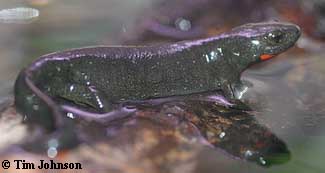 Chinese firebellies (C. orientalis) usually have smooth skin... |
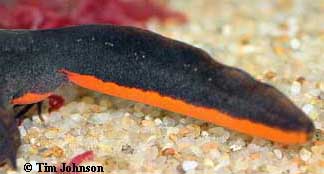 ... and rounded tails. |
Japanese Fire Belly Newt (Cynops pyrrhogaster)
Japanese fire bellies have more granular, or rougher skin, than the Chinese Fire Belly. We're not talking a slight difference in texture, but a big difference. They are also a bit larger as adults, from 9-13 cm (3-5 in). The end of their tail is sharply pointed, not rounded like the Chinese species. Typically the belly pattern appears to be more speckled rather than blotched, but a few races of C. pyrrhogaster do have blotches. They usually have more prominent parotoid glands (bumps at the back of the head on each side).
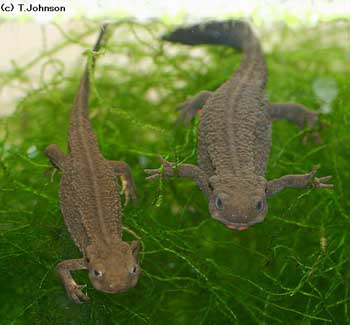 Japanese firebellies (C. pyrrhogaster) usually have bumpy skin, obvious parotoid glands... |
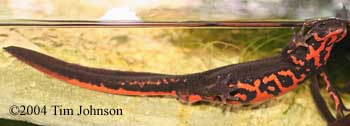 ... and pointed tails. |
Paddletail Newt (Pachytriton)
In the past, these newts were sometimes labeled as firebellies or giant firebellies. They can be easily distinguished by having a tail shaped like a boat paddle (gets bigger toward the end). Paddletails have extremely smooth, almost slimy feeling skin. Adults are rather large, and can get bigger than 13 cm (5 in).

Paddletail newts have smooth skin and a broad paddle-like tail.
Newt shown is a typical Pachytriton labiatus, the most common species
of paddletail.
Warty Newt (Paramesotriton sp.)
In the past, these were also sometimes labeled as a type of firebelly. Most have very bumpy, warty skin. And they can be easily identified by having a black belly with red or orange spots, instead of a red belly with black spots as in the above species. Typically, they are brown, but a few species are moss green. Adult warty newts are generally larger than the Chinese or Japanese firebellies, with typical sizes around 12-15 cm (5-6 inches).
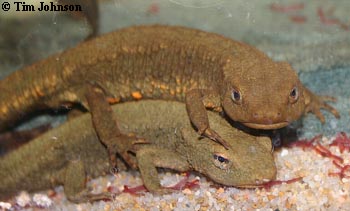
Warty newts look very different from other kinds of "firebellies". Shown is Paramesotriton fuzhongensis.
I hope after considering the above information you can identify your newt and use this identification to find the information you need to care for your animal correctly. For caresheets and more pictures of each type, use the following links:
Chinese firebelly: Cynops orientalis
Japanese firebelly: Cynops pyrrhogaster
Chinese Warty Newt: Paramesotriton chinensis
Hong Kong Warty Newt: Paramesotriton hongkongensis
Fuzhong Warty Newt: Paramesotriton fuzhongensis
